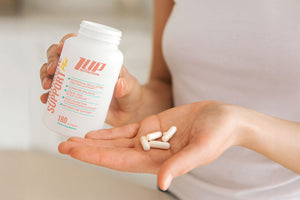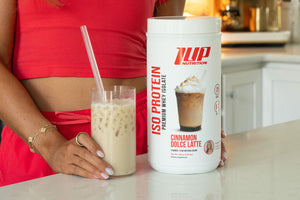There’s no getting around it -- the holidays are here and for many that presents a real challenge to their nutrition plan.
Make no mistake, the food during the holidays is fantastic, borderline epic. It comes in every shape, size, taste, texture, and flavor profile possible...that doesn’t necessarily mean it’s the most figure-friendly food either.
Fear not!
Just because the holidays are here doesn’t mean you have to completely go off your diet nor does it mean you have to suffer through some rather insipid-tasting bland, dry food.
Here are some macro-friendly holiday meal swaps that allow you to enjoy the foods you crave during the holidays while staying on track with your transformation challenge!
Upgrade the Hors d'oeuvre
Typical appetizer platters at social gatherings and family dinners are filled with dry, stale bread, crackers, and/or greasy chips all of which surround a canned sour cream and onion dip.
Keep the classic dip and scoop appetizer tray, but give it a much better-tasting (and healthier!) upgrade by putting out an assortment of fresh sliced veggies and whole-grain crackers. And for the dip? Ditch the sour cream-based dips for protein and fiber-rich hummus and/or guacamole.
If you’re looking for a fruit-based dessert option, you can make your own dip-and-serve dessert tray by slicing fresh fruit and making a protein-packed dip by combining 1 cup of greek yogurt with 1 scoop of whey protein (fyi coconut ice cream or tres leches work phenomenally well here).
Rethink Your Mashes
Mashed potatoes are a staple side dish of many holiday feasts, especially Thanksgiving. They’re rich, creamy, buttery, and all-together delicious...they’re also chock-full of fat, carbs, and calories.
You can still enjoy your mashed potato goodness this holiday season, but try replacing a portion of the potatoes in the recipe with a less-starchy vegetable, such as parsnips, cauliflower, or turnips.
Once these veggies are roasted and mashed together with your potatoes, you won’t even notice the difference from a taste and texture standpoint, but you’ll be saving hundreds of calories (literally). For instance, one cup of mashed cauliflower has ~30 calories and only 5 grams of carbs, while one cup of mashed potatoes has 160 calories and 36 grams of carbohydrates! Aside from the carbohydrate savings, you’ll also be upping the micronutrient intake of one of your favorite holiday dishes!
Get Nutty with Sweet Potatoes
Sweet potato casserole is another delicious mash that is found atop many Thanksgiving tables.
Unfortunately, the nutrient-rich sweet potato is gussied up with gobs of added sugar and butter, and then topped with a thick layer of marshmallows. In the end, this healthy-looking holiday meal usually contains as much sugar as a slice of apple pie!
One easy fix right away is to strip away the layer of marshmallows and replace it with a layer of chopped pecans and a light drizzle of honey. You’ll add some much needed texture and healthy fats from the pecans and get just enough sweetness from the light drizzle of honey.
Remember, sweet potatoes already contain plenty of healthy natural sugars and don’t need a bunch of extra added refined sugar mixed into them.
If you’re looking to further reduce the total carb content of your sweet potato casserole, try mixing in some other winter squash, such as butternut or acorn, with your sweet potatoes.
As we mentioned with the mashed potatoes, you’ll still get the same silky texture all the while significantly reducing the total carb count.
Go Green
One thing that is usually lacking at holiday meals are greens.
And no, green bean casserole (which is usually a pool of canned green beans swimming in a sea of canned mushroom soup and topped with fried onions) doesn’t count.
Adding some greenery to your holiday table can help bring new flavors and textures to your holiday feast and at the same time helping you to eat less, since greens are high in fiber and food volume for relatively low calories.
Ditch the green bean casserole (permanently) and replace it with bacon-wrapped asparagus, roasted Brussels sprouts, or collard greens cooked with bits of diced ham (a very lean protein). If you’re really married to the idea of green beans at the holiday table, then try swapping the asparagus for bacon-wrapped green bean bundles.
Get Crazy with Cranberries
Cranberry sauce is a devious dish -- it masquerades as a healthy side dish (berries are a “superfood” after all), but really most cranberry sauces you’ll encounter this holiday season (especially the canned varieties) pack enough added sugar to qualify as a dessert!
In fact, a mere 1/4 cup of canned cranberry sauce can contain over 25 grams of sugar!
Instead of going for the canned route this holiday season, try preparing your own cranberry sauce. It really is easy to do yourself. Just buy a bag of fresh or frozen cranberries, toss it into a saucepan over medium heat along with a splash of water, some fresh-squeezed orange juice and a touch of erythritol (or other low/zero-calorie sweetener) and cook it until the berries start to burst and everything becomes thick and delicious.
You can also experiment and tweak the flavor and texture profile to your needs, such as adding chopped pecans or orange zest to the finished product.
Be Careful with the Holiday “Cheer”
Eggnog, cocktails and other adult beverages represent a significant source of calories during the holidays (as well as other times of year) for many individuals.
Each gram of alcohol contains 7 calories, and that’s not including all of the other mixers that typically go into creating these holiday beverages.
If you are imbibing this holiday season (always do so responsibly), stick to lower calorie options like red wine, spritzers, or one really exceptional cocktail. After than, transition to water or other zero-calorie beverages.
You Are Master of Your Domain
A key factor to remember at the holidays is that you are ultimately in charge of what goes on your plate (and therefore in your mouth).
As such, when building your plate at meal time, be smart.
Start with protein (turkey, ham, etc.) and then build from there. Protein requires more energy for your body to digest than other macronutrients and it also helps fill you up more than either carbs or fat, which can help prevent overeating.
At the end (and beginning!) of the day, it’s all about how you balance your plate. The good news is there are typically plenty of options to choose from. Fill the plate first with the turkey or ham, the mixed green salad, the roasted After you have your protein portion on the plate, then add the mixed greens and veggies. Only after the protein and veg is taken care of should you add the carb-heavy dishes. Building your plate in this manner also helps limit the amount of room on your plate for the calorie-dense foods, which acts as a means of calorie control.
Takeaway
The holidays are a time to relax, unwind, and enjoy time with family, friends, and loved ones.
Yes, eating healthy and staying physically active are important. At the same time, “don’t let good be the enemy of great.” By that, we mean that you are supposed to “enjoy” yourself this holiday season. You don’t have to track every last piece of food down to the morsel (though you can do so if you want).
If you have a little something that’s off of your diet plan, that’s ok, too. You haven’t ruined all of your hard work to this point and you can still get phenomenal results during your transformation challenge.
The overarching idea is to make the best choices possible, nutritionally, physically, and emotionally, and with that mindset you will be able to enjoy the holidays and still get great results!






